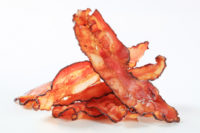Sausage Holds Steady
By Andy Hanacek, executive editor
Although retail sales leveled off in 2005, the popularity of sausage in foodservice has kept the product front and center.
On first glance, 2005 may look like a wash as far as the sales of sausage go. But when you factor in the foodservice arena, sausage continued to ride its wave of popularity among those consumers who eat away from home, particularly during breakfast.
In 2005, sales of refrigerated dinner sausage, refrigerated breakfast sausage, and frozen sausage were down from the same numbers in 2004, according to data supplied by Chicago-based Information Resources, Inc. (IRI).
ConAgra Foods Inc., which owns the top-selling brand of frozen sausage — Armour Brown ’N Serve Sausage — announced in early February its plans to divest itself of most of its refrigerated meats businesses, a group that produced annual sales, according to a company release, of about $1.9 billion.
Although Armour meats and hot dogs, Butterball turkey, and Eckrich smoked sausages fall into that category, ConAgra is not putting the Healthy Choice, Hebrew National, Brown ’N Serve, Slim Jim, or Pemmican lines up for sale.
For some companies, 2005 was a good sales year.
Take, for instance, Kohler, WI-based Johnsonville Sausage Co., which ranked second among vendors in refrigerated dinner sausage dollar sales based on 2005 IRI data. Johnsonville has done its part in promoting the category, and saw a nice rise in sales in 2005, while many of its competitors in refrigerated dinner and breakfast sausages had an off year.
Not only has Johnsonville used memorable commercials to support its line of sausages, but it has also attempted to educate the consumer through news releases. One such release prior to the 2005 summer barbecue season, for example, spread the word that 90 percent of consumers were grilling bratwurst at the wrong temperature — high heat. Johnsonville suggested to consumers that they grill the brats over indirect, medium heat, and scolded those who “commit the ultimate sin against the bratwurst — piercing the skin and cutting into the brat to test if it is done.”
Those efforts certainly paid off for Johnsonville, which saw a nearly four percent jump in dollar sales across all its brands in both the dinner sausage and breakfast sausage categories, bringing it a step closer to the category lead in each.
Sara Lee Foods oversaw the rollout of new Jimmy Dean Skillets, a line of three skillets that features sausage in its Sausage and Southwest Style varieties. Another take on the convenience that consumers crave, the skillets can be prepared in 10 minutes for a quick and easy breakfast option.
In the foodservice arena things have become more focused for sausage in recent years. Sausage flexed its muscle as a breakfast feature on menus over the past five years and solidified its status as a breakfast necessity for consumers who choose to eat out.
According to data from the Foodservice Research Institute’s MenuMine database, restaurants and foodservice institutions find ways to work sausage into nearly every area of their daily menus.
Yet, when it comes down to it, sausage retains a much more focused position in the foodservice arena. Case in point: Of the 1,710 menu items containing sausage in the 1,066 restaurants and institutions polled by the MenuMine database in 2005, more than 1,100 items — a whopping 66.1 percent — were termed “breakfast” items. Sausage was listed as part of a sandwich or pizza in only 310 menu items, or 18.1 percent of dishes listing sausage as a component.
Further evidence of the breakfast dominance over the sausage industry can be found when the data is broken down by the type of cuisine the menu items appear in. MenuMine shows that 608 items containing sausage appear in foodservice institutions specializing in the “Cuisines for Breakfast” category. That 35 percent share of the 1,710 menu items has gone up since 2000, when the same category featured only 28.5 percent of the sausage menu items (of 741 items listed in 2000).
Family-dining chains and independent restaurants in that segment are the most frequent end-users of sausage in the foodservice realm, checking in three segments among the top four foodservice segments serving sausage, according to the data. However, it should be noted that non-commercial institutions, such as colleges, hospitals, and industries, contribute more than 250 menu items to the list, more than 15 percent as a group.
More data on the retail and foodservice sales of sausage and hot dogs can be found in the charts that accompany this report. Retail information is provided by IRI, and foodservice data was collected from the Foodservice Research Institute’s MenuMine database. NP


Report Abusive Comment